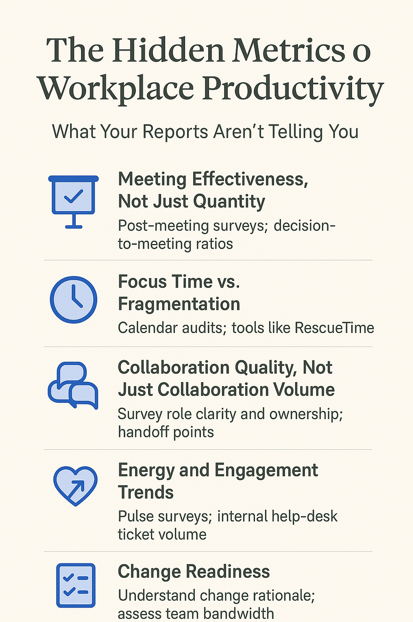When it comes to workplace productivity, most organizations track visible outputs—things like hours logged, tasks completed, or project deadlines met. But these surface-level indicators don’t always tell the full story. In fact, the hidden metrics of workplace productivity—the ones buried beneath the data—can have the biggest impact on team performance.
At Productivity Advocates, we specialize in uncovering what traditional dashboards overlook. In this post, we’ll explore five critical, often-missed areas that can make or break your productivity strategy

1. Meeting Effectiveness (Not Just Quantity)
Tracking how many meetings happen per week is easy. Measuring whether those meetings move work forward? That’s a hidden metric of workplace productivity that many organizations ignore.
Why it matters:
Ineffective meetings don’t just waste time—they fragment focus and breed frustration. A bloated calendar is a symptom of unclear decision-making processes or a lack of trust in asynchronous communication.
How to measure it:
- Post-meeting surveys (2 questions max)
- Tracking decision-to-meeting ratios
- Time-to-action after meetings
Further Reading: Stop the Meeting Madness
2. Focus Time vs. Fragmentation
Employees may work 8+ hours, but how much of that is uninterrupted, high-quality focus time?
Why it matters:
Frequent interruptions—whether through Slack, emails, or meetings—destroy deep work. Teams with more “maker time” tend to produce higher-quality work faster.
How to measure it:
- Use calendar audits to count blocks of 90+ uninterrupted minutes
- Use tools like RescueTime or Clockwise (with transparency and consent)
3. Collaboration Quality, Not Just Collaboration Volume
It’s tempting to look at messages sent or shared documents as a sign of teamwork—but more isn’t always better.
Why it matters:
Excessive collaboration can indicate unclear roles, dependency overload, or fear of autonomy.
How to measure it:
- Survey employees on the clarity of roles and ownership
- Look at handoff points and time-to-complete for joint projects
Explore tools like Miro for improving team communication.
4. Energy and Engagement Trends
Engagement surveys once a year aren’t enough. Energy dips can show up weekly or even daily—and often precede drops in output.
Why it matters:
Low energy leads to quiet quitting, burnout, and turnover, long before the metrics show it.
How to measure it:
- Pulse surveys (weekly 1-question check-ins)
- Track internal help-desk ticket volume and HR inquiries as early indicators
5. Change Readiness
A team might be highly skilled, but that doesn’t mean they’re ready for your next initiative or transformation.
Why it matters:
Resistance to change often slows productivity before a change even begins. Misalignment here can sabotage even the best strategies.
Why it matters:
Resistance to change often slows productivity before a change even begins. Misalignment here can sabotage even the best strategies.
How to measure it:
- Ask: “Do you understand why this change is happening?” and “Do you believe it will benefit your work?”
- Assess team bandwidth and trust in leadership before rollout
The Bottom Line
If you’re relying only on output numbers or system logs, you’re getting a partial—and potentially misleading—picture of your organization’s productivity.
True productivity lives at the intersection of behavior, systems, and culture. At Productivity Advocates, we help organizations surface these invisible drivers with diagnostic tools, targeted surveys, and data-informed strategies.
Want to uncover your team’s hidden productivity barriers?

